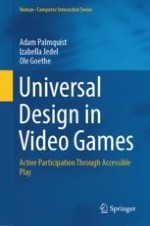Video games constitute an important part of peoples’ lives, both from an entertainment perspective and for purposes that go beyond entertainment. For society to become inclusive, video games need to be inclusive. Inclusivity, accessibility
, and usability
are central concepts of the design of product, services, and experiences. Historically, these terms have been used differently depending on the lens of which one views design. The design lenses of inclusivity all strive toward a more accessible society but differ in terms of the processes underlying how inclusivity is achieved. Viewing video games from a Universal Design
lens moves us from a consideration of accessibility
in light of disability, toward reaching attainable game experiences
for people with various different conditions
beyond disability. In Chap.
1, we present the term Universal Design
, how it emerged from interrelated design lenses and the key takeaways underlying the term, followed by a presentation of Universal Design
in video games. Thereafter the discussion centers around the concept’s disability, accessibility
, and usability
, and how these terms relate to Universal Design
in general and Universal Design
in video games specifically. Based on the contextualization of Universal Design
in the video game space, we propose a definition for Universal Design
in video games which centers around promoting an attainable gaming experience (AGE). The objective of the chapter is to provide an overview about historical and current considerations of accessibility
and inclusivity to understand how you can approach inclusivity and a Universal Design
approach in video games from a more nuanced perspective.
